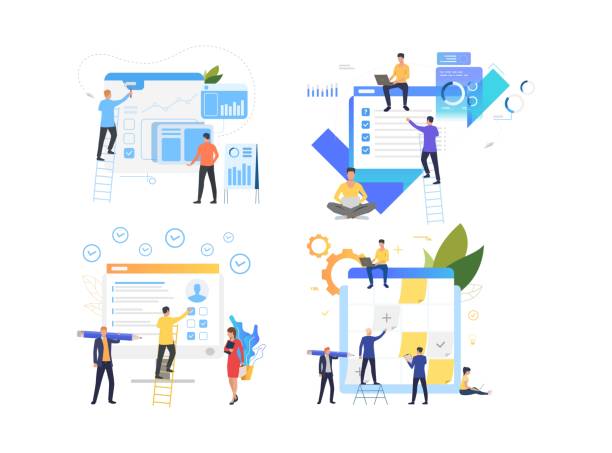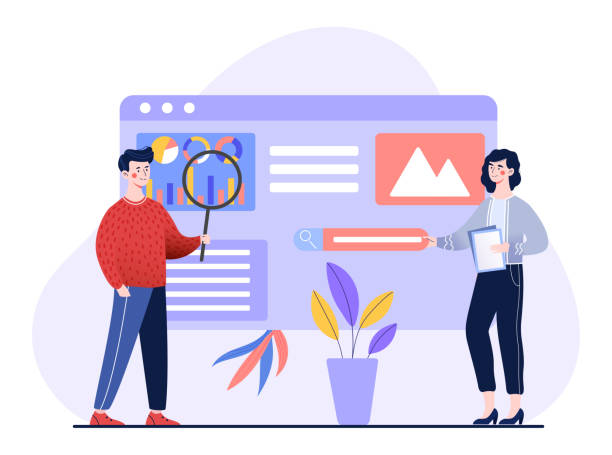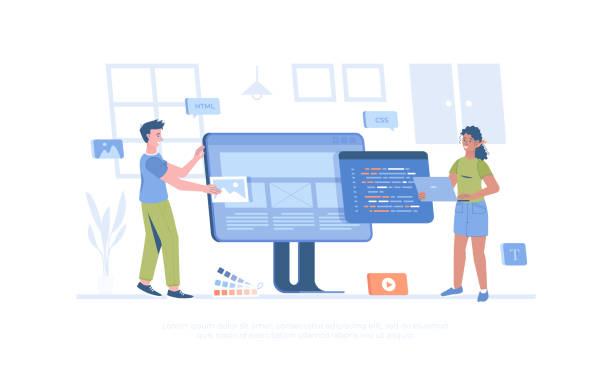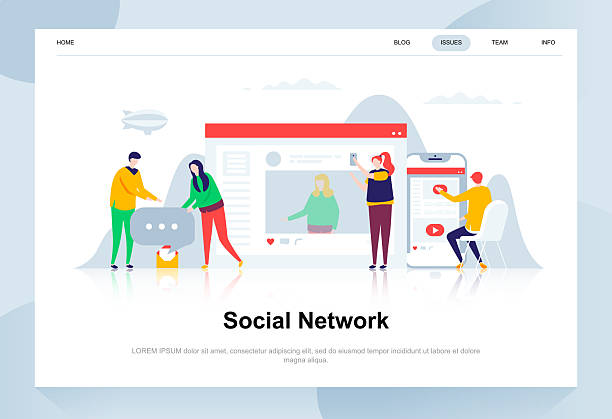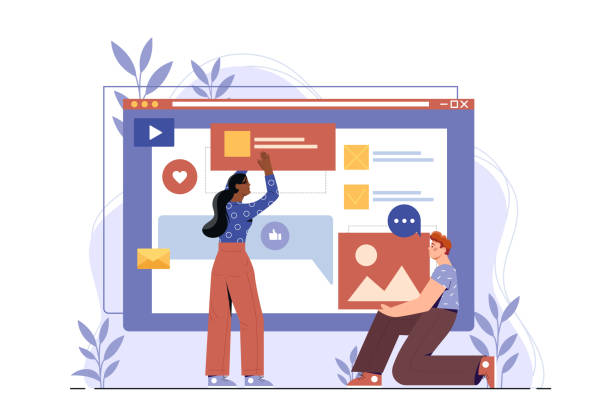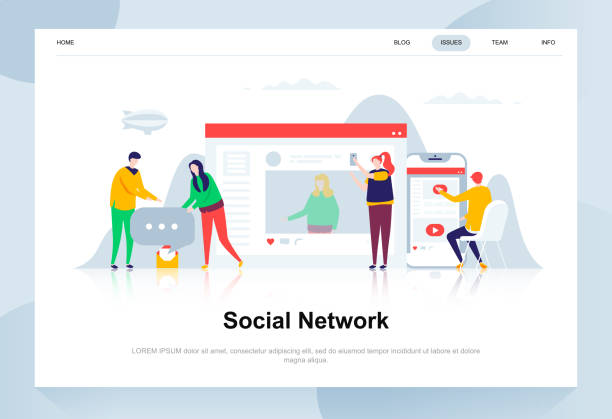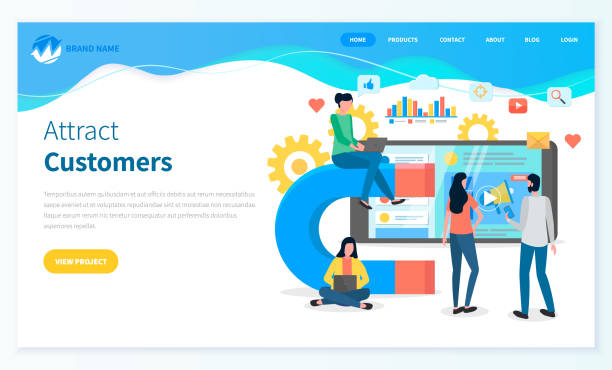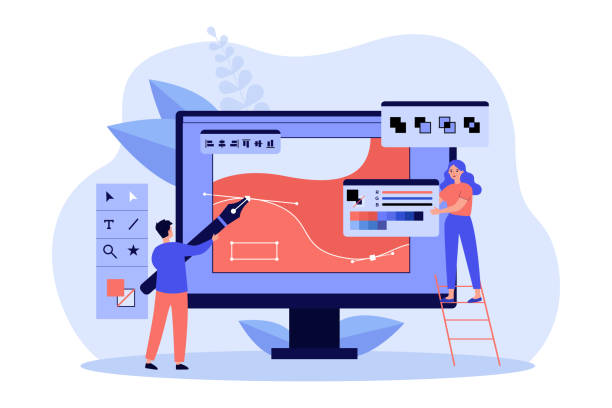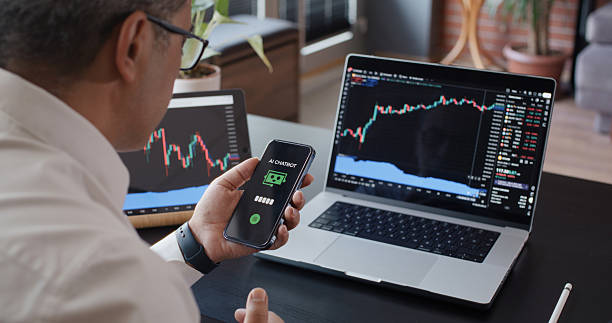1. Why is E-commerce Website Design Critical Today?
In the current digital age, #e-commerce_website_design is no longer a luxury choice but a necessity for the survival and growth of any business.
With increasing internet access and a shift in people’s shopping habits towards online shopping, a strong presence in the virtual space through an efficient e-commerce website can open new doors to sales and business development.
This approach not only removes geographical limitations but also provides access to potential customers anywhere in the world.
This section provides a complete explanation about the importance and reasons for needing an online sales platform.
One of the key advantages of having an online store is the ability to operate 24/7, allowing customers to access your products anytime, anywhere.
This flexibility not only improves the customer shopping experience but also significantly increases sales opportunities.
Furthermore, the operational costs of an online store are typically lower than physical stores, as there is no need for rent, heavy utility bills, or a large sales staff.
This allows you to allocate more capital to product development, marketing, or improving customer service.
Recent data analysis shows that the share of e-commerce in the total retail market is increasing year by year, and this trend will continue, making entry into this arena vital for any brand seeking sustainability and growth.
These fundamental changes in business methods necessitate that business owners step towards building their online store with sufficient knowledge.
Does your company website create a professional and lasting first impression in the minds of potential customers? Rasawb, with professional corporate website design, not only represents your brand’s credibility but also paves a path for your business growth.
✅ Create a powerful and reliable brand image
✅ Attract target customers and increase sales
⚡ Get free consultation
2. Key Elements in Successful E-commerce Website Design
In the #e-commerce_website_design process, paying attention to certain key elements is essential to ensure the site’s success and efficiency.
This section #specialized and #educational introduces and explains these elements.
The first and perhaps most important element is User Interface (UI) and User Experience (UX).
An attractive and visual user interface along with a smooth and hassle-free user experience encourages users to spend more time on your site and increases the likelihood of purchase.
Responsive Design, which optimizes your site for display on various devices including mobile phones and tablets, is an undeniable necessity today.
The second element is a strong Content Management System (CMS) that allows you to easily add, edit, and manage your products, monitor inventory, and update prices.
This system must provide the necessary features for product categorization, adding full descriptions, high-quality images, and product videos.
Additionally, the presence of a powerful search engine within the site helps users quickly find the product they are looking for.
Site loading speed is also of high importance; sites that load slowly cause users to leave and harm your SEO ranking.
Finally, diverse and secure payment options, an efficient shopping cart, and a simple and fast checkout process are other vital elements.
The easier it is for the customer to go through the purchase stages, the higher the probability of completing the purchase.
Customer reviews, a Frequently Asked Questions (FAQ) section, and clear contact information also help increase customer #trust and form an efficient online sales platform.
3. Choosing the Right Platform for E-commerce Website Design
Choosing the right #platform is one of the most important decisions in the #e-commerce_website_design process.
This decision affects not only costs and development time but also the scalability, security, and future efficiency of your store.
In this section, we provide a comprehensive analysis of available options.
Platforms are generally divided into two main categories: Open-Source like WooCommerce and Magento, and SaaS (Software as a Service) platforms like Shopify and Wix.
WooCommerce, which is a plugin for WordPress, offers high flexibility and is ideal for those who want full control over their code and hosting.
However, it requires more technical knowledge for setup and maintenance.
Magento is also a powerful option for larger companies with complex needs, but it comes with high complexity and cost.
In contrast, Shopify is a ready-to-use and user-friendly solution that doesn’t require deep technical knowledge and allows for quick store setup, but it has less flexibility in customization and involves fixed monthly costs.
The right choice depends on your budget, technical knowledge, business size, and long-term goals.
For example, if you intend to create an online store website with very specific and unique features, open-source platforms might be a better choice.
| Feature | WooCommerce | Shopify | Magento |
|---|---|---|---|
| Platform Type | Open-Source (WordPress) | SaaS (Cloud Service) | Open-Source (Standalone) |
| Ease of Use | Medium (requires WordPress knowledge) | High (very user-friendly) | Low (complex) |
| Flexibility and Customization | Very High | Medium | Very High |
| Initial Cost | Low (host and domain) | Fixed Monthly | High (implementation and maintenance) |
| Scalability | High (with proper hosting) | High (with higher plans) | Very High (for enterprise) |
| Support | Community and Developers | Provided by Shopify | Community and Developers |
4. Importance of User Experience (UX) in E-commerce Website Design
#User_Experience or UX in #e-commerce_website_design plays a pivotal role in the success or failure of an online store.
UX is not only limited to the visual aesthetics of the site but encompasses all aspects of user interaction with your website.
This section provides a comprehensive guide to improving UX on e-commerce websites.
Good UX enables users to easily navigate the site, find the product they are looking for, obtain sufficient information about it, and complete the purchase process without any issues.
Attractive visual design, high loading speed, organized menus, clear Call-to-Action (CTA) buttons, and logical placement of elements are among the factors that contribute to an improved user experience.
One of the key principles in UX design is simplicity and intuitiveness.
Unnecessary complexities in design or the purchase process can lead to users quickly leaving the site.
You must ensure that the add-to-cart and checkout processes are as simple and step-by-step as possible.
Additionally, providing a consistent user experience across all devices through responsive design is very important.
Today, a significant portion of web traffic comes from mobile devices, and if your site is not optimized for mobile, you will lose a large segment of your potential customers.
High-quality visual content, such as product images from various angles and short videos, plays a crucial role in helping customers make decisions.
Also, the ability to filter and sort products based on different attributes (such as price, color, brand) helps users narrow down their options and quickly find what they want.
Do not forget that customer reviews and feedback can also provide valuable clues for continuous improvement of your site’s UX.
This is an online sales platform that must prioritize customer needs.
Did you know that poor online store design can drive away up to 70% of your potential customers? Rasawb revolutionizes your sales with professional and user-friendly e-commerce website designs.
✅ Significant increase in sales and revenue
✅ Full optimization for search engines and mobile
⚡ [Get free online store design consultation from Rasawb]
5. Payment Gateways and Security in E-commerce Website Design
The issue of #security in #e-commerce_website_design, especially in the payment gateway section, is of vital importance.
This is a #specialized discussion that requires particular care and attention.
Customers will only make online purchases if they have complete trust in the security of their personal and financial information.
Choosing secure and reputable payment gateways is the first step in building this trust.
Intermediate payment gateways like ZarinPal, IDPay, or direct bank transfers each have their own advantages and disadvantages that should be selected based on the business type and customer preferences.
All these gateways must use advanced security protocols such as SSL/TLS for encrypting sensitive data.
An SSL (Secure Sockets Layer) certificate, which starts the site address with “https://”, indicates the security of data sent and received between the user and the server, playing an important role in gaining user trust and improving the site’s SEO ranking.
Furthermore, adherence to PCI DSS (Payment Card Industry Data Security Standard) security standards is essential for any online store that processes payment card information.
Fraud prevention mechanisms should also be considered, such as fraud detection systems that identify suspicious patterns in transactions.
Beyond payment gateways, overall website security, including regular platform and plugin updates, use of Web Application Firewalls (WAF), regular data backups, and monitoring for suspicious activities, is important.
A successful e-commerce website always prioritizes security so that customers can shop with peace of mind.
Ensuring that any sensitive customer information is transferred encrypted and protected is the foundation of a reliable e-commerce business.
6. Product and Content Management in E-commerce Website Design
The #product_and_content_management section is a very important aspect of #e-commerce_website_design that directly impacts customer experience and their purchasing decisions.
This process provides practical #guidance and #explanatory for best practices.
For each product, precise and complete information must be provided; including attractive and unique descriptions, technical specifications, dimensions, weight, material, and applications.
These descriptions not only help customers better understand the product but are also important for SEO, as they help search engines better understand your site’s content.
Using high-quality images from various angles of the product is a necessity.
Additionally, image galleries, zoom capabilities, and even product videos can significantly enhance the customer’s visual experience.
Short videos demonstrating product usage or highlighting its prominent features are very effective in increasing sales.
Logical and hierarchical product categorization is also crucial for user navigation ease.
Customers should be able to easily move between categories and find their desired product in the shortest possible time.
Furthermore, other sections such as customer reviews, a Frequently Asked Questions (FAQ) section for each product, and blog articles related to your products or industry help enrich site content and increase user engagement.
Blog content can include buying guides, product comparisons, or industry-related news that not only creates added value for users but also significantly helps improve the site’s SEO ranking.
An e-commerce platform with rich and high-quality content has a greater chance of attracting and retaining customers.
Click here to preview your posts with PRO themes ››
7. SEO for E-commerce Website Design: How to Be Seen?
#SEO (Search Engine Optimization) is of paramount importance in #e-commerce_website_design.
Without a strong SEO strategy, even the best products and the most beautiful website might not be seen among a multitude of competitors.
This section provides a specialized guide to improving your online store’s visibility.
The main goal of SEO is to rank high in Google and other search engine results for keywords relevant to your products.
This means attracting organic (free) traffic and increasing sales potential.
The first step in SEO is keyword research.
You need to identify the words that your potential customers use to search for similar products.
Then, naturally and intelligently incorporate these keywords into your product titles, descriptions, Meta Descriptions, Header Tags, and page URLs.
Image optimization (compression for faster speed and use of descriptive Alt Text) is also very important.
SEO also includes technical site optimization such as loading speed, friendly URL structure, and XML sitemap.
Additionally, building quality backlinks from reputable websites and creating valuable and relevant content (such as blog articles, buying guides) helps improve your domain authority with search engines.
Continuous monitoring of SEO performance using tools like Google Analytics and Google Search Console to identify strengths and weaknesses and make necessary adjustments is essential for any online store website.
Through continuous optimization, you can ensure that your store is always accessible to customers.
| SEO Factor | Description | Importance |
|---|---|---|
| Product Keyword Research | Identifying words and phrases customers use to find your products. | Very High |
| Product Description Optimization | Including keywords, rich, and unique descriptions on product pages. | High |
| Site Loading Speed | Reducing page load times to improve user experience and SEO ranking. | Very High |
| Responsive Design (Mobile-Friendly) | Ensuring proper and user-friendly display of the site on all devices, especially mobile. | Very High |
| URL Structure and Navigation | Hierarchical and logical URL and menu structure for easy access. | High |
| Backlink Building | Acquiring links from reputable and relevant sites to increase domain authority. | High |
8. Marketing and Promotion for E-commerce Websites
After the #e-commerce_website_design is complete, the real work begins: attracting customers and promoting products.
This stage requires a comprehensive #marketing strategy that can drive targeted traffic to your online store.
This is an #analytical and sometimes #entertaining topic with incredible growth potential.
Content marketing, including publishing blog articles, guides, and educational videos related to your products or industry, not only helps with SEO but also builds customer trust.
Creating engaging and useful content can establish you as an authority in your industry.
Social media marketing is another powerful method for connecting with customers and increasing brand awareness.
An active presence on platforms like Instagram, Telegram, Facebook, and LinkedIn, depending on your target audience, can help you showcase your products in a visual and appealing way, interact with your followers, and reach new customers through targeted advertising.
Collaborating with relevant influencers and bloggers can also help increase your reach.
Paid Ads like Google Ads and social media advertising are quick ways to attract targeted traffic.
These methods allow you to directly target individuals who are looking for your products or have similar interests.
Email marketing campaigns are also very effective for maintaining communication with existing customers and encouraging repeat purchases, as well as attracting new customers through newsletters and special offers.
Every digital marketing strategy should be accompanied by data analysis and results to achieve the best outcomes.
Is your current e-commerce website design not delivering the expected sales?
Rasawb is an expert in professional e-commerce website design!
✅ An attractive and user-friendly site aimed at increasing sales
✅ High speed and security for an ideal shopping experience⚡ [Get free online store design consultation from Rasawb]
9. Maintenance and Data Analysis in E-commerce Websites
After launch and marketing, #maintenance and #data_analysis are of vital importance.
A successful e-commerce website requires continuous care and updates to always perform optimally.
This is a #specialized and #explanatory discussion that helps ensure the sustainability of your store.
Maintenance includes regular updates of the platform, plugins, and site theme to ensure security and proper functioning.
Additionally, continuous monitoring for broken links, checking page loading speeds, and fixing potential errors help improve user experience and SEO.
Regular backups of site data and the database are a non-negotiable necessity.
This prevents data loss in case of technical issues, cyber attacks, or human errors.
Without backups, all your efforts in #building_an_online_store and its content could easily be lost.
Data analysis using tools like Google Analytics and Google Search Console gives you deep insight into user behavior and site performance.
You can see how users come to your site, which pages they view, how long they spend on the site, and at which stages of the purchase they abandon the site.
This information helps you identify site weaknesses and make data-driven decisions to improve conversion rates and increase sales.
For example, if many users exit the site during the payment stage, you might need to simplify the payment process or offer more payment options.
Continuous data analysis allows you to improve your e-commerce website design and optimize it for your customers.
Click here to preview your posts with PRO themes ››
10. The Future of E-commerce Website Design and Innovations
The world of #e-commerce_website_design is constantly evolving, and embracing #innovations and future trends is vital for sustainability in this competitive market.
This section provides thought-provoking and #news-oriented content that helps you stay on the right track.
One of the most important future trends is the growth of Voice Commerce, which allows users to make purchases with voice commands.
With the expansion of voice assistants like Siri, Alexa, and Google Assistant, optimizing stores for voice searches and the ability to purchase through these interfaces will become increasingly important.
Augmented Reality (AR) and Virtual Reality (VR) also have high potential to change the online shopping experience.
Imagine customers being able to virtually place furniture in their homes or simulate clothes on themselves.
These technologies can bridge the gap between online and physical shopping and make the shopping experience much more engaging and realistic.
Advanced personalization based on Artificial Intelligence is another trend that allows stores to offer highly accurate and relevant suggestions tailored to each customer’s taste and purchase history, significantly helping to increase conversion rates and customer loyalty.
AI-powered chatbots, capable of answering customer questions, providing support, and even guiding them through the purchase process, are rapidly becoming a standard.
These chatbots can offer 24/7 support and dramatically improve the customer experience.
The future of #e-commerce is rapidly moving towards smart and interactive e-commerce websites.
Is your business ready to embrace these changes? This is the fundamental question you must answer to maintain your competitive edge and move forward with #building_an_online_store with a view to the future.
Frequently Asked Questions
| Question | Answer |
|---|---|
| What is e-commerce website design? | It is the process of creating an online platform for selling products or services, which includes designing the User Interface (UI), User Experience (UX), and necessary functionalities for online purchasing. |
| What are the key features of a good e-commerce website? | Easy navigation, high loading speed, strong search capability, efficient shopping cart, secure payment gateway, clear product display with high-quality images, ability to show user reviews, and responsiveness (mobile compatibility). |
| What platforms are common for e-commerce website design? | Popular platforms include WooCommerce (on WordPress), Shopify, Magento, PrestaShop, and also custom Content Management Systems. |
| What is the importance of an e-commerce website being responsive? | Given the increasing use of mobile for online shopping, a responsive website (correct display on different screen sizes) is crucial for providing a good user experience and increasing conversion rates. |
| How long does the process of designing an e-commerce website usually take? | The duration depends on the project’s complexity, the number of products, required special features, and the implementation method, and can vary from a few weeks to several months. |
And other services of Rasawb Advertising Agency in the field of advertising
Smart Digital Branding: A dedicated service for growth in customer acquisition based on precise audience targeting.
Smart Digital Advertising: Professional optimization for user interaction using attractive UI design.
Smart Sales Automation: A combination of creativity and technology to increase click-through rates through SEO-driven content strategy.
Smart Marketing Automation: Revolutionize website visits with the help of real data.
Smart Advertorial: A novel service to increase customer acquisition through custom programming.
And over hundreds of other services in the field of internet advertising, advertising consultation, and organizational solutions
Internet Advertising | Advertising Strategy | Advertorial
Resources
Complete Guide to E-commerce Website SEO
WordPress E-commerce Website Design Tutorial
Zero to Hundred E-commerce Website Design
Advantages of Having an Online Store
? Are you ready to transform your business in the digital world? Rasawb Afarin, a leading digital marketing agency, paves your path to growth by offering comprehensive services including custom website design, SEO, and advertising campaign management.
📍 Tehran, Mirdamad Street, Next to Central Bank, Kazeroon South Alley, Ramin Alley, No. 6

